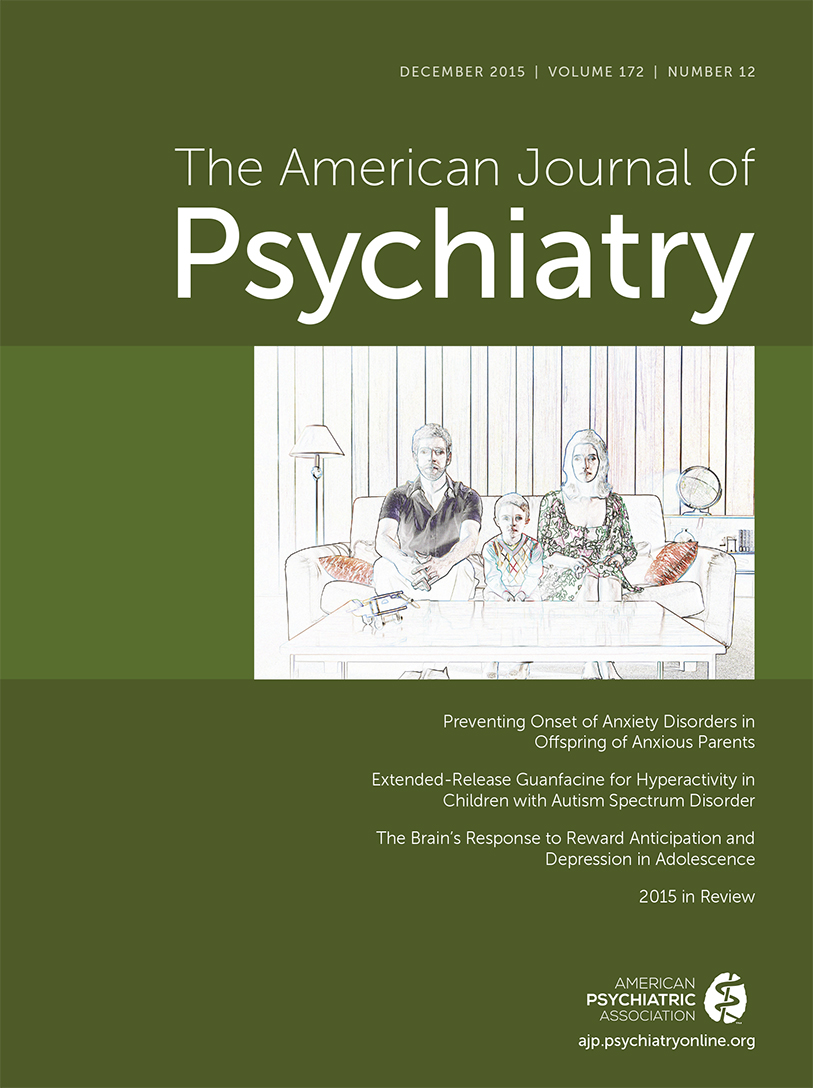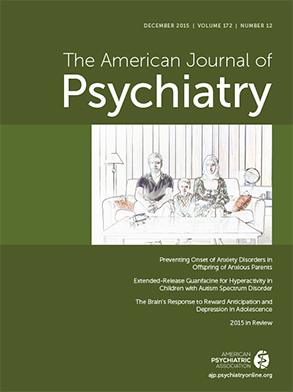In this issue, Papakostas and colleagues report on the first randomized controlled trial of adjunctive ziprasidone in major depressive disorder (
1). Patients entered an 8-week open-label trial of escitalopram with the dosage adjusted up to 30 mg/day if needed. Nonresponders were randomized to receive adjunctive ziprasidone or placebo double-blind for 8 weeks. Ziprasidone was started at 20 mg b.i.d. and then increased if needed by 20 mg b.i.d. up to a maximum dosage of 80 mg b.i.d. Adjunctive ziprasidone was more effective than placebo in achieving response on the Hamilton Depression Rating Scale and the self-reported Quick Inventory of Depressive Symptoms (QIDS-SR). The difference between adjunctive ziprasidone and placebo for remission failed to achieve significance on the HAM-D but was significant on the QIDS-SR. On two secondary outcomes, adjunctive ziprasidone was more effective than placebo for anxiety symptoms but was not more effective for treatment of pain. During the 8-week randomized phase, 33% of the ziprasidone group and 22% of the placebo group discontinued treatment. The difference in overall discontinuation rates appeared to reflect the significantly higher rate of dropout due to adverse events—14% in the ziprasidone group, compared with none in the placebo group. The most common adverse event was somnolence (33.8% and 11.7% in the ziprasidone and placebo groups, respectively). Akathisia occurred in 15.4% of patients in the ziprasidone group and 7.3% in the placebo group. Mean weight gain was 3.5 kg in the ziprasidone group and 1.0 kg in the placebo group. The QTc interval on ziprasidone had a modest increase of 8.8 ms, which approached statistical significance (p=0.06).
This was a well-conducted and well-described high-quality study. The use of prospective initial treatment with escitalopram ensured that patients had failed at least one trial. As the authors note, the change in HAM-D scores in the placebo group, 3.3, is one of the lowest change scores reported for an adjunctive trial, suggesting that the initial open-label escitalopram trial was effective and that little further improvement occurred during the next 8 weeks when placebo was added to escitalopram.
Readers will wonder how ziprasidone compares with other atypical antipsychotics when used adjunctively. First note that, to date, this is the only controlled trial of adjunctive ziprasidone that has been published. The number needed to treat for ziprasidone was 7, which is similar to the other atypicals; however, the 95% confidence interval for the number needed to treat in this sample of 139 patients is very broad. As a result, we should be very cautious about efficacy comparisons. The relatively high rate of discontinuation due to adverse events is similar to the rate for the 300 mg/day dosage of extended-release quetiapine (
2). As with quetiapine, somnolence is the most frequent side effect of ziprasidone. In this study, 34% of patients in the ziprasidone group experienced somnolence or fatigue. In an earlier open study of adjunctive ziprasidone (
3), 20% (4/20) of patients discontinued treatment because of adverse events and 50% experienced somnolence. In another open study of adjunctive ziprasidone (
4), 39% (16/41) discontinued treatment because of adverse events, and both insomnia and somnolence were common. On other parameters, the rate of akathisia with ziprasidone was lower than with aripiprazole but greater than with quetiapine or olanzapine (
2). Weight gain was less with ziprasidone than with olanzapine but greater than with aripiprazole or quetiapine. The present study suggests that adjunctive ziprasidone is effective in major depression, but it appears to have a relatively high rate of discontinuation due to adverse events and a high level of somnolence compared with other atypicals.
Adjunctive trials in treatment-resistant depression that employ an initial prospective antidepressant trial are difficult to conduct. About a third of patients beginning the prospective trial proceed to the randomized phase. In this study, 147 of the 458 patients who started open-label treatment discontinued treatment before completion of the open phase. Of the 311 patients who completed the open phase, 172 responded and thus did not proceed to the randomized phase. Thus, only 139 of the 458 patients enrolled in the trial (30.3%) entered the adjunctive phase of the trial. A recent trial of adjunctive aripiprazole in older adults with major depression (
5) reported similar patient flow numbers—of the 468 patients who began an open prospective trial of venlafaxine, 191 responded to venlafaxine and 96 discontinued treatment, leaving 181 (38.7%) to be randomized for adjunctive treatment.
The prospective lead-in may not be necessary. As part of a meta-analysis of trials of adjunctive atypical antipsychotics in major depression (
6), Dr. Papakostas and I examined the drug-placebo difference in trials in which treatment nonresponse was determined with a prospective trial or by history. Drug-placebo differences were similar in the two designs, but absolute response rates were lower in patients who failed a prospective trial (38.6% and 25.8% for drug and placebo, respectively) than in patients who failed treatment by history (55.2% and 42.7%, respectively). Subsequently, Iovieno and Papakostas (
7) also found that the prospective/historical distinction did not affect the drug-placebo difference in pooled data from 35 adjunctive trials using different types of adjunctive agents. They also found that absolute response and remission rates were lower after a prospective trial than after a failed trial by history. These data indicate that a prospective lead-in results in a more treatment-resistant sample, but a prospective trial does not enhance signal detection (finding of a drug-placebo difference).
At this time, the database for adjunctive trials of atypical antipsychotics in major depression is much larger than for any other adjunctive treatment. There have been 19 published trials (16 reviewed previously [
6], three additional trials of aripiprazole [
5,
8,
9], and the trial of ziprasidone reported in this issue). In July 2015, brexpiprazole, a new atypical antipsychotic, was approved by the U.S. Food and Drug Administration (FDA) for adjunctive use in major depression based on two positive phase 3 trials (
10). These 22 trials include 5,531 patients. By comparison, the next best studied adjunctive agent, in terms of number of controlled trials, is lithium, with 10 double-blind randomized controlled trials including 271 patients (
11). Only three of these trials, with a total of 76 patients, added lithium to a selective serotonin or serotonin-norepinephrine reuptake inhibitor, the agents most likely to be used as the initial antidepressant. In addition, unlike the trials of atypical antipsychotics that employed some method of defining treatment resistance, only three lithium trials added lithium after a minimum of 6 weeks of prior antidepressant treatment.
The primary limitations of the atypical agents have been tolerability, safety, and cost. In a review of the tolerability of three of the adjunctive agents approved for use in major depression, Citrome (
2) found that the rates of discontinuation due to adverse events were as follows: aripiprazole, 3.8%; olanzapine (with fluoxetine), 11.6%; extended-release quetiapine at 150 mg/day, 8.9%; and extended-release quetiapine at 300 mg/day, 15.4%. The rate of discontinuation due to adverse events in the three published risperidone trials was 6.5% (
6), and for the two phase 3 brexpiprazole trials, 2.6% (
12). These rates appear no worse than those for adjunctive bupropion and adjunctive buspirone in the Sequenced Treatment Alternatives to Relieve Depression study, which were 12.5% and 20.6%, respectively (
13). The only head-to-head comparison of an adjunctive atypical antipsychotic with a non-antipsychotic adjunctive agent (
14) found similar rates of discontinuation due to adverse events for extended-release quetiapine and lithium (10.0% and 7.9%, respectively).
The major safety issue has been the potential of the atypical antipsychotics to cause weight gain and adverse metabolic effects. Weight gain associated with olanzapine is considerable and has been well described (
15). Some of the newer atypical agents appear to be associated with less weight gain, but most of the controlled data examining weight gain or metabolic indices come from short-term trials. Yet clearly weight gain is a long-term issue. Each of the FDA-approved atypical agents has undergone at least one open-label long-term trial. However, it is unclear to what extent other factors, such as improvement in the depression, may contribute to weight gain in these uncontrolled trials. In a 50-week study of fluoxetine and placebo, Michelson et al. (
16) found that 26.7% of patients on placebo for 50 weeks gained ≥7% body weight and that weight gain was associated with poor appetite at entry and appetite improvement with recovery. In a study of 32 depressed older patients, Weber et al. (
17) noted that weight gain during 12 weeks of antidepressant treatment was related to weight loss during depression and suggested that patients were returning to their pre-depression weight. Long-term controlled trials should help sort out how much of the weight gain is drug related. Tardive dyskinesia remains a potential safety concern, but in open-label long-term trials of atypicals, rates of tardive dyskinesia have been very low (0.0%–0.4%), and these rates do not account for spontaneous cases of tardive dyskinesia (
18–
20).
Although the acute efficacy of the adjunctive atypical antipsychotics is well established, the major shortcoming is the dearth of long-term placebo-controlled studies that would inform clinicians about persistence of efficacy or burden of adverse effects. Only two studies have been performed. In one (
18), risperidone failed to have a significant effect in preventing relapse; however, methodological problems may have contributed to the result. A recent 26-week relapse prevention study of the olanzapine-fluoxetine combination (
21) showed a significant advantage for the combination. In that trial, after 6–8 weeks of acute treatment with olanzapine and fluoxetine and 12 weeks of stabilization, patients were randomly assigned to the combination or to fluoxetine plus placebo. A time-to-relapse analysis significantly favored the combination. Under the primary definition of relapse, 15.8% of the patients on the combination relapsed, compared with 31.8% of the patients on fluoxetine. Nevertheless, the paucity of long-term controlled studies for the atypical agents limits our understanding of the persistence of efficacy and of side effects that may increase or emerge with time. This leaves the clinician whose patient has responded to acute adjunctive treatment with little information for weighing the risks and benefits of continuing the adjunctive agent.

